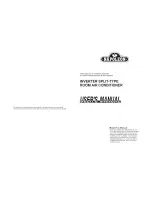
4
Figure 2. Typical Air Conditioning and Heat Pump System Connections
distributor body and tighten it to 10-12 ft./lbs
of torque. If no torque wrench is available,
hand tighten and then tighten an additional
1/4 turn.
6.
If not already done so, release pressure
from the coil by removing the valve cap
and then depressing the valve on the end
of the liquid line. Remove the valve core
and dispose of properly.
7.
Unbraze and remove the cap on the suction
line. Unbraze and remove the valve core
holder on the liquid line.
8.
Cut the line set tubing to the proper length.
Be sure that the tubing has been sized in
accordance with the outdoor unit specifi ca-
tions.
9.
Inspect both refrigerant lines. The ends of
the lines must be round, clean, and free of
any burrs.
10. Insert the line set tubes into the coil tube
stubs until they bottom out.
11. Braze the individual connections with dry
nitrogen fl owing through the joints to elimi-
nate internal oxidation and scaling.
12. Check the assembly for leaks.
13. Properly dispose of all removed parts.
WARNING:
To avoid the risk of electric shock,
personal injury or death, discon-
nect all electrical power to the unit
before performing any maintenance
or service.
4. ELECTRICAL WIRING
General —
Electrical power wiring must be made
in accordance with all applicable local codes and
ordinances, and with the current revision of the
National Electric Code (ANSI/NFPA 70). If any of
the original wire as supplied with the unit must be
replaced, it must be replaced with wire material
having the same gauge and temperature rating.
G R W
Thermostat
Green
Red
White
G
R
Grey
Y
C
Air Handler
A/C OD Section
Y
Typical Air Conditioner w/Air Handler
G R W 2C E O Y
Thermostat
Green
Red
White
G
R
Grey
O Y
R
C
Air Handler
Heat Pump OD
Section
Typical Heat Pump w/Air Handler
W 2
C
C
W 1
W 1
NOTE: Jumper
between W2 and E is
required when no OD
T-Stat is used.
OD
Stat
E
Yellow
Yellow


























